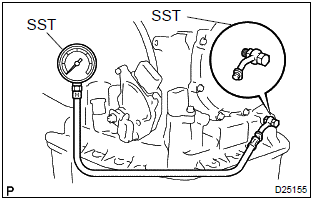Toyota Corolla (E120): Hydraulic test
1. Perform hydraulic test
- Measure the line pressure.
Notice
:
- Do the test at normal operation atf temperature 50 to 80 °c (122 to 176 °f).
- The line pressure test should always be carried out in pairs. One technician should observe the conditions of wheels or wheel stopper outside the vehicle while the other is doing the test.
- Be careful to prevent sst’s hose from interfering with the exhaust pipe.

- Warm up the atf.
- Remove the test plug on the transaxle case front left
side and connect sst.
Sst 09992–00095 (09992–00231, 09992–00271)
- fully apply the parking brake and chock the 4 wheels.
- Connect an obd ii scan tool or hand–held tester to the dlc3.
- Start the engine and check the idling speed.
- Keep your left foot pressed firmly on the brake pedal and shift into the d position.
- Measure the line pressure when the engine is idling.
- Depress the accelerator pedal all the way down.
Quickly read the highest line pressure when the engine speed reaches the stall speed.
- Do the test in the r position in the same way.
Specified line pressure:

Evaluation:
|
Problem |
Possible cause |
| If the measured values at all positions are higher |
|
| If the measured values at all positions are lower |
|
| If pressure is low in the d position only |
|
| If pressure is low in the r position only |
|
Other materials:
Diagnostic trouble code chart
The inspection procedures are shown in the table below. This table allows
efficient and accurate troubleshooting
using the diagnostic trouble codes displayed in the diagnostic trouble code
chart. Proceed with
troubleshooting in accordance with the inspection procedures listed in the
diagnost ...
Head restraints
Head restraints are provided
for all seats.
WARNING
■Head restraint precautions
Observe the following precautions
regarding the head restraints.
Failure to do so may result in
death or serious injury.
Use the head restraints
designed for each respective
seat.
Adjust the head restraints to th ...
Using the rear view monitor system
■ Screen description
1 Vehicle width guide lines
The line indicates a guide path when the vehicle is being backed straight up.
The displayed width is wider than the actual vehicle width.
2 Vehicle center guide lines
These lines indicate the estimated vehicle center on the ground.
3 Dis ...


